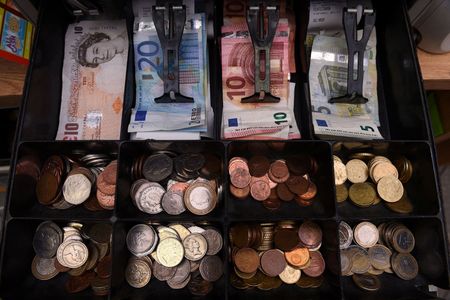
By John McCrank and Gertrude Chavez-Dreyfuss
NEW YORK (Reuters) – The euro on Tuesday rallied from 22-month lows against the U.S. dollar hit the previous session, lifted by expectations that the euro zone will increase fiscal spending to help offset the economic effects of the Russia-Ukraine conflict, which pushed energy and other commodity prices higher.
Europe’s single currency, which has been bearing the brunt in the foreign exchange market of the geopolitical turmoil’s financial impact, also gained versus other currencies such as the yen, Swiss franc, and sterling.
“We’ve seen a lot of headlines, the largest of which has been around the supranational bond issuance in the euro zone, and therefore the likelihood of increased fiscal spending in that region, which is why we’ve seen euro-dollar react the way it has,” said Simon Harvey, senior FX market analyst at Monex Europe in London.
Bloomberg News reported on Tuesday that the European Union plans to jointly issue as soon as this week bonds on a potentially massive scale to finance energy and defense spending.
Also on Tuesday, international oil benchmark Brent crude backed off Monday’s 14-year high of just under $140 per barrel, which helped boost euro sentiment. Brent though was still up 6.5% on Tuesday at $131.11.
The euro regained some ground after five sessions of declines versus the dollar. It was up more than a cent from a trough of $1.0806 on Monday, its lowest since March 2020 when the COVID-19 pandemic gripped Europe.
The single currency was last up 0.3% at $1.0890.
The euro briefly traded at parity with the Swiss franc on Monday for the first time in seven years. It rose 0.8% on Tuesday to 1.012 francs.
Traders are expecting choppy markets over the next few months, with euro/dollar volatility gauges at their highest since the market chaos of March 2020
Traders are also looking ahead to the European Central Bank policy meeting on Thursday, with the prospect of stagflation prompting economists to suggest that policymakers might delay rate hikes until late in the year.
As the euro gained, the dollar index, which measures the greenback against a basket of six global peers, was flat to slightly lower at 99.15.
That said, the safe-haven dollar remains an in-demand asset despite Tuesday’s slight pullback. Since Russia’s invasion on Feb. 24, the dollar has gained around 3.3% as the crisis has intensified.
U.S. dollar demand was also evident in the cross-currency swaps market. The cost of raising U.S. dollar funds in the euro swaps market was 17 basis points in favor of the greenback. That though was lower than last week’s level when it hit around 40 basis points, the highest since March 2020.
Still the numbers suggested that there is still a shortage of dollars in funding markets. Besides the commodities’ rally, the war and subsequent Western sanctions have crushed Russian assets, with the rouble falling to a record low of 160 to the dollar in erratic offshore trade on Monday. The rouble on Tuesday though firmed 2.6% versus the greenback, which fell to 131.5.
(Reporting by John McCrank and Gertrude Chavez-Dreyfuss in New York; Additional reporting by Iain Withers in London and Tom Westbrook in Singapore; Editing by Ed Osmond, Chizu Nomiyama and Jonathan Oatis)

